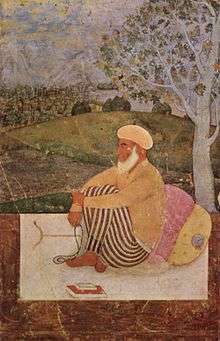Chilla (retreat)

Chilla (Persian: چله, Arabic: أربعين, both literally "forty") is a spiritual practice of penance and solitude in Sufism known mostly in Indian and Persian traditions. Elsewhere the practice is often referred to as Khalwa. In this ritual a mendicant or ascetic attempts to remain seated in a circle practicing meditation techniques without food for 40 days and nights in imitation of the Arba'een.[1][2] The fan chilla is derived from the Persian word chehel "forty".[3] Chilla is commonly performed in a solitary cell called a chilla-khana.
In Hindustani classical music
A practice similar to chilla is also performed by Hindustani classical music practitioners at an advanced level.It is called chilla katna. The musicians lock themselves up in a chilla-khana for forty days and practice their instrument severely. A special diet, often omitting meat and grains, is taken during this period and very little food is eaten. Any contact to the outside world is avoided during this period. People try not to fall asleep at any cost, if necessary they will tie their hair to a noose at the ceiling. It is done to achieve a very high level of skill, that cannot be achieved due to normal regular practice. The chilla details may differ between gharanas (musical lineages).
Many Indian classical musicians have confessed about going into chilla when they felt that they were at a crossroads where they could not see the path ahead clearly. They have also described chilla as an extremely intense, private and exhausting experience.[4] Ustad Zakir Hussain went into a chilla, at the Dargah of Haji Mallam, with just his tabla as companion for 40 days.[5]
People who have performed partial or complete chillas
The most famous case of chilla is found in the biographies of the 14th century Sufi poet Hafez of Shiraz.[6][7][8] Similarly, the tabla maestro Zakir Hussain describes having gone into chilla at the age of 16 during his first experience of fame, in an attempt to rediscover music.[9]
See also
References
- ↑ Landolt & Lawson 2005, p. 203.
- ↑ Dehlvi 2012, p. 109.
- ↑ The Path of Khalwati and Shabani Archived 2005-01-11 at the Wayback Machine.
- ↑ "Ustad Zakir Hussain @ Algebra live". Algebra talks (you tube). Missing or empty
|url=(help);|access-date=requires|url=(help) - ↑ Kabir, Nasreen Munni (15 January 2018). Zakir Hussain: a life in music (1 ed.). Harper Collins India. ISBN 9352770498.
|access-date=requires|url=(help) - ↑ Teachings of Hafiz: Translated by Gertrude Lowthian Bell
- ↑ Hafiz حافظ Biography
- ↑ Iran Chamber Society
- ↑ Kubiak, David. "On Musical Chakras, Chilla and Uncharted Epiphanies - a conversation with Ustad Zakir Hussain". Kyoto journal. Retrieved 6 September 2018.
Bibliography
- Dehlvi, Sadia (5 September 2012). Sufism: Heart of Islam. HarperCollins Publishers. ISBN 978-93-5029-448-2.
- Landolt, Hermann; Lawson, Todd (2005). Reason and Inspiration in Islam: Theology, Philosophy and Mysticism in Muslim Thought. I.B.Tauris. ISBN 978-1-85043-470-2.